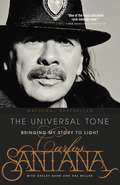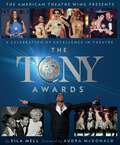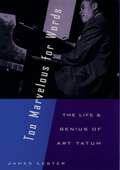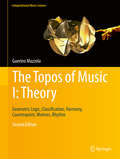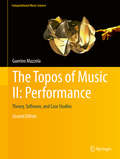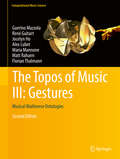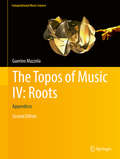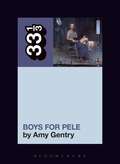- Table View
- List View
Tonic to the Nation: Making English Music in the Festival of Britain
by Nathaniel G. LewLong remembered chiefly for its modernist exhibitions on the South Bank in London, the 1951 Festival of Britain also showcased British artistic creativity in all its forms. In Tonic to the Nation, Nathaniel G. Lew tells the story of the English classical music and opera composed and revived for the Festival, and explores how these long-overlooked components of the Festival helped define English music in the post-war period. Drawing on a wealth of archival material, Lew looks closely at the work of the newly chartered Arts Council of Great Britain, for whom the Festival of Britain provided the first chance to assert its authority over British culture. The Arts Council devised many musical programs for the Festival, including commissions of new concert works, a vast London Season of almost 200 concerts highlighting seven centuries of English musical creativity, and several schemes to commission and perform new operas. These projects were not merely directed at bringing audiences to hear new and old national music, but to share broader goals of framing the national repertory, negotiating between the conflicting demands of conservative and progressive tastes, and using music to forge new national definitions in a changed post-war world.
El Tono Universal: Sacando mi Historia a la Luz
by Carlos SantanaThe intimate and long-awaited autobiography of a legend. In 1967 in San Francisco, just a few weeks after the Summer of Love, a young Mexican guitarist took the stage at the Fillmore Auditorium and played a blistering solo that announced the arrival of a prodigious musical talent. Two years later -- after he played a historic set at Woodstock -- the world came to know the name Carlos Santana, his sensual and instantly recognizable guitar sound, and the legendary band that blended electric blues, psychedelic rock, Latin rhythms, and modern jazz, and that still bears his name. Carlos Santana's unforgettable memoir offers a page-turning tale of musical self-determination and inner self-discovery, with personal stories filled with colorful detail and life-affirming lessons. The Universal Tone traces his journey from his earliest days playing the strip bars in Tijuana while barely in his teens and brings to light the establishment of his signature guitar sound; his roles as husband, father, recording legend, and rock guitar star; his indebtedness to musical and spiritual influences -- from John Coltrane and John Lee Hooker to Miles Davis and Harry Belafonte; and his deep, lifelong dedication to a spiritual path that he developed from his Catholic upbringing, Eastern philosophies, and other mystical sources. It includes his recording some of the most popular and influential rock albums of all time, up to and beyond the 1999 sensation Supernatural, which garnered nine Grammy Awards and stands as arguably the most amazing career comeback in popular music history. It's a profoundly inspiring tale of divine inspiration and musical fearlessness that does not balk at finding the humor in the world of high-flying fame, or at speaking plainly of Santana's personal revelations and the infinite possibility he sees in each person he meets. "Love is the light that is inside of all of us, everyone," he writes. "I salute the light that you are and that is inside your heart."
Tonsetzerinnen: Zur Rezeption von Komponistinnen in Deutschland um 1800 (Edition Centaurus – Beiträge zur Kultur- und Sozialgeschichte der Musik)
by Ruth HeckmannRuth Heckmann geht der Frage nach, wie man um 1800 über Musik und Musizierende, insbesondere über komponierende Frauen sprach. Sie zeigt, wie Frauen in der sich etablierenden bürgerlichen Musikkultur im nord- und mitteldeutschen Raum von ihrer Umwelt wahrgenommen und häufig kritisch beäugt wurden. Außerdem stehen die Musikerinnen und Komponistinnen Corona Schröter, Louise Reichardt und Sophie Westenholz im Mittelpunkt dieses Buches. Gefragt wird, wie ihr Wirken von Zeitgenossen und Nachwelt gesehen wurde und welche Strategien sie in einer von Männern dominierten und von männlichen Interessen geleiteten Kultur entwickelten, um öffentlich erfolgreich wirken zu können.
Tonus Peregrinus: The History of a Psalm-tone and its use in Polyphonic Music
by Mattias LundbergMattias Lundberg investigates the historical role of a deviant psalm-tone, the tonus peregrinus, focusing on its applications in polyphonic music within all major branches of Western liturgy. Throughout the remarkably persistent tradition of applying this melody to polyphony, from the ninth century right up to the twenty-first, coeval music theory is able to shed light on the problems it has posed to modal and tonal practice at various historical stages. The musical settings studied hold up a mirror to the general development of psalmody, concerning practices of organum, diverse regional forms of fauxbourdon, cantus firmus composition, free imitation, parody, fugue, quodlibet, monody, and many other compositional techniques where the unique features of the psalm-tone have necessitated modification of existing practices. The conclusions drawn reveal a musico-liturgical tradition that was not in real danger of extinction until the general decline of Western liturgy that followed in the eighteenth century, at which point the historiography of the tonus peregrinus became a factor stimulating scholarly and musical interest in its alleged pre-Christian origins. Lundberg demonstrates that the succession of works based on the tonus peregrinus often preserved a distinctly conservative musical and theological conception even during periods of drastic liturgical reform.
Tonus Peregrinus: The History of a Psalm-tone and its use in Polyphonic Music
by Mattias LundbergMattias Lundberg investigates the historical role of a deviant psalm-tone, the tonus peregrinus, focusing on its applications in polyphonic music within all major branches of Western liturgy. Throughout the remarkably persistent tradition of applying this melody to polyphony, from the ninth century right up to the twenty-first, coeval music theory is able to shed light on the problems it has posed to modal and tonal practice at various historical stages. The musical settings studied hold up a mirror to the general development of psalmody, concerning practices of organum, diverse regional forms of fauxbourdon, cantus firmus composition, free imitation, parody, fugue, quodlibet, monody, and many other compositional techniques where the unique features of the psalm-tone have necessitated modification of existing practices. The conclusions drawn reveal a musico-liturgical tradition that was not in real danger of extinction until the general decline of Western liturgy that followed in the eighteenth century, at which point the historiography of the tonus peregrinus became a factor stimulating scholarly and musical interest in its alleged pre-Christian origins. Lundberg demonstrates that the succession of works based on the tonus peregrinus often preserved a distinctly conservative musical and theological conception even during periods of drastic liturgical reform.
The Tony Awards: A Celebration of Excellence in Theatre
by Eila Mell The American Theatre WingCommemorating over 75 years of Broadway greatness with never-before told stories, rare photos from the American Theatre Wings' archives, and interviews with major honorees like Lin-Manuel Miranda, Patti LuPone, and Hugh Jackman, The Tony Awards is the official, authorized guide to Broadway's biggest night.The Tony Awards: A Celebration of Excellence in Theatre pays tribute to the magic that happens when the curtain goes up and Broadway's best and brightest step onto center stage. Supported by the American Theatre Wing, the arts organization that founded the Tony Awards in 1947 and continues to produce the Tony Awards live telecast each year, author Eila Mell has interviewed a cavalcade of past and present Tony winners, including actors, producers, writers, costume designers, and many many others. Their voices fill the pages of this book with fascinating, behind-the-scenes stories about what it's like to win the theatre world's highest honor. Featuring a foreword by Audra McDonald and over 400 color and black-and-white photographs, The Tony Awards also spotlights more than 130 captivating interviews with a parade of industry insiders, including: Mel Brooks, Matthew Broderick, Carol Burnett, Kristin Chenoweth, Glenn Close, James Corden, Bryan Cranston, Neil Patrick Harris, Jennifer Holliday, Hugh Jackman, John Kander, Angela Lansbury, Judith Light, Hal Linden, Kenny Leon, Patti LuPone, Lin-Manuel Miranda, Brian Stokes Mitchell, Rita Moreno, Bernadette Peters, Chita Rivera, Martin Short, Tom Stoppard, Julie Taymor, Leslie Uggams, and Sir Andrew Lloyd Webber.
Too Late To Stop Now: More Rock’n’Roll War Stories
by Allan JonesMore than 40 stories from the glory days of rock'n'roll, featuring Lou Reed, Elton John, Sting and The Clash.Allan Jones brings stories – many previously unpublished – from the golden days of music reporting. Long nights of booze, drugs and unguarded conversations which include anecdotes, experiences and extravagant behaviour. - A band's aftershow party in San Francisco being gatecrashed by cocaine-hungry Hells Angels- Chrissie Hynde on how rock'n'roll killed The Pretenders- What happened when Nick Lowe and 20 of his mates flew off to Texas to join the Confederate Air Force- John Cale on his dark alliance with Lou Reed Allan Jones remembers a world that once was – one of dark excess and excitement, outrageous deeds and extraordinary talent, featuring legends at both the beginnings and ends of their careers.
Too Late To Stop Now: More Rock’n’Roll War Stories
by Allan JonesMore than 40 stories from the glory days of rock'n'roll, featuring Lou Reed, Elton John, Sting and The Clash.Allan Jones brings stories – many previously unpublished – from the golden days of music reporting. Long nights of booze, drugs and unguarded conversations which include anecdotes, experiences and extravagant behaviour. - A band's aftershow party in San Francisco being gatecrashed by cocaine-hungry Hells Angels- Chrissie Hynde on how rock'n'roll killed The Pretenders- What happened when Nick Lowe and 20 of his mates flew off to Texas to join the Confederate Air Force- John Cale on his dark alliance with Lou Reed Allan Jones remembers a world that once was – one of dark excess and excitement, outrageous deeds and extraordinary talent, featuring legends at both the beginnings and ends of their careers.
Too Marvelous for Words: The Life and Genius of Art Tatum
by James LesterArt Tatum defined the limits of the possible in jazz piano. Gunther Schuller called Tatum's playing "a marvel of perfection.... His deep-in-the-keys full piano sonority, the tone and touch control in pyrotechnical passages...are miracles of performance." Whitney Balliett wrote "no pianist has ever hit notes more beautifully. Each one--no matter how fast the tempo--was light and complete and resonant, like the letters on a finely printed page." His famous runs have been compared to the arc left against the night sky by a Fourth-of-July sparkler. And to have heard him play, one musician said, "was as awe-inspiring as to have seen the Grand Canyon or Halley's Comet." Now, in Too Marvelous For Words, James Lester provides the first full-length biography of the greatest virtuoso performer in the history of jazz. Before this volume, little was known about Tatum, even among jazz afficionados. What were his origins, who taught him and who provided early pianistic influences, how did he break into the jazz field, what role did he play in the development of other jazz players, and what was he like when he wasn't playing? To answer these questions, Lester has conducted almost a hundred interviews for this book, with surviving family, childhood friends, schoolteachers, and the famous jazz musicians who played with him or knew him. Lester creates a memorable portrait of this unique musician and of the vibrant jazz world of the 1930s and 1940s, capturing the complexity and vitality of this remarkable performer. Tatum, who was virtually blind, suffering between 70% and 90% visual impairment, emerges as cheerful, fun-loving, energetic and out-going, with none of the demonic self-destructiveness that seemed to haunt such jazz greats as Charlie Parker or Billie Holiday. He often joked about his blindness, but did not like it mentioned as a handicap and preferred to pre-plan his entrance to the piano in a club, rather than have someone lead him there. He was simply inexhaustible and had a life-long habit of staying up all night after a gig, usually seeking an after-hours club in which to listen and play until daybreak. Lester also reveals that Tatum was generous with younger players, but his extraordinary technical brilliance often devastated them. No less a talent than Oscar Peterson remembers that after first hearing Tatum, "I gave up the piano for two solid months, and I had crying fits at night." And Les Paul remarked that after hearing Tatum for the first time, he quit piano completely and began playing guitar. Perhaps most important, Lester provides a thorough, knowledgeable discussion of Tatum's music, from his early influences, such as stride pianist Fats Waller, to his mature style in which Liszt, Rachmaninoff, Debussy, Waller, and Earl Hines all became grist for his harmonic mill. From unexceptional origins in Toledo, Ohio, Art Tatum evolved into a world-class musician whose importance in jazz is comparable to Louis Armstrong and Charlie Parker and whose command of the piano captured the admiration of Horowitz and Paderewski. Too Marvelous For Words is the first full portrait of this extraordinary musical genius.
Too Much Too Young: Rude Boys, Racism and the Soundtrack of a Generation
by Daniel RachelIn 1979, 2 Tone exploded into the national conscience as records by The Specials, The Selecter, Madness, The Beat, and The Bodysnatchers burst onto the charts and a youth movement was born.2 Tone was black and white: a multi-racial force of British and Caribbean island musicians singing about social issues, racism, class and gender struggles. It spoke of injustices in society and took fight against right wing extremism.The music of 2 Tone was exuberant: white youth learning to dance to the infectious rhythm of ska and reggae; and crossed with a punk attitude to create an original hybrid. The idea of 2 Tone was born in Coventry, masterminded by a middle-class art student raised in the church. Jerry Dammers had a vision of an English Motown. Borrowing £700, the label's first record featured 'Gangsters' by The Specials' backed by an instrumental track by the, as yet, unformed, Selecter. Within two months the single was at number six in the national charts. Dammers signed Madness, The Beat and The Bodysnatchers as a glut of successive hits propelled 2 Tone onto Top of the Pops and into the hearts and minds of a generation. However, soon infighting amongst the bands and the pressures of running a label caused 2 Tone to bow to an inevitable weight of expectation and recrimination. Still under the auspices of Jerry Dammers, 2 Tone entered in a new phase. Perhaps not as commercially successful as its 1979-1981 incarnation the label nevertheless continued to thrive for a further four years releasing a string of fresh signings and a stunning end-piece finale in '(Free) Nelson Mandela'. Told in three parts, Too Much Too Young is the definitive story of a label that for a brief, bright burning moment, shaped British culture.
Too Much Too Young: Popular Music Age and Gender
by Sheila WhiteleyToo Much Too Young investigates how age and gender have shaped the careers and images of pop music stars, examining the role of youth and youthfulness in pop music through a series of themed case studies. Whiteley begins by investigating the exploitation of child stars such as Brenda Lee and Michael Jackson, offering a psychoanalytic reading of the relationship between child star and oppressive manager, and looks at the current glut of boy- and girl- bands and stars in the mold of Britney Spears to examine the continuing fatal attraction of stardom for adolescents. Whiteley then considers the star images of female singer-songwriters Kate Bush, Tori Amos, and Bjork, whose 'little girl' voices and characterization by the media suggests a girlish feminitity which is often at odds with the intentions of their musical output. She then moves on to explore the rock/pop divide as it affects the image of male performers, considering why male stars usually fall into the category of 'wild boys' such as Kurt Cobain or Jim Morrison, or 'nice boys', like Cliff Richard, The Monkees, and Wham! Whiteley ends by asking what happens to stars who set so much store by manipulations of youthfulness when they begin to age, and points to stars like Robbie Williams, Kylie Minogue and Cher to demonstrate that it is possible to achieve iconic pop status even without dying young.
Too Much Too Young: Popular Music Age and Gender
by Sheila WhiteleyToo Much Too Young investigates how age and gender have shaped the careers and images of pop music stars, examining the role of youth and youthfulness in pop music through a series of themed case studies. Whiteley begins by investigating the exploitation of child stars such as Brenda Lee and Michael Jackson, offering a psychoanalytic reading of the relationship between child star and oppressive manager, and looks at the current glut of boy- and girl- bands and stars in the mold of Britney Spears to examine the continuing fatal attraction of stardom for adolescents. Whiteley then considers the star images of female singer-songwriters Kate Bush, Tori Amos, and Bjork, whose 'little girl' voices and characterization by the media suggests a girlish feminitity which is often at odds with the intentions of their musical output. She then moves on to explore the rock/pop divide as it affects the image of male performers, considering why male stars usually fall into the category of 'wild boys' such as Kurt Cobain or Jim Morrison, or 'nice boys', like Cliff Richard, The Monkees, and Wham! Whiteley ends by asking what happens to stars who set so much store by manipulations of youthfulness when they begin to age, and points to stars like Robbie Williams, Kylie Minogue and Cher to demonstrate that it is possible to achieve iconic pop status even without dying young.
Top 40 Democracy: The Rival Mainstreams of American Music
by Eric WeisbardIf you drive into any American city with the car stereo blasting, you’ll undoubtedly find radio stations representing R&B/hip-hop, country, Top 40, adult contemporary, rock, and Latin, each playing hit after hit within that musical format. American music has created an array of rival mainstreams, complete with charts in multiple categories. Love it or hate it, the world that radio made has steered popular music and provided the soundtrack of American life for more than half a century. In Top 40 Democracy, Eric Weisbard studies the evolution of this multicentered pop landscape, along the way telling the stories of the Isley Brothers, Dolly Parton, A&M Records, and Elton John, among others. He sheds new light on the upheavals in the music industry over the past fifteen years and their implications for the audiences the industry has shaped. Weisbard focuses in particular on formats—constructed mainstreams designed to appeal to distinct populations—showing how taste became intertwined with class, race, gender, and region. While many historians and music critics have criticized the segmentation of pop radio, Weisbard finds that the creation of multiple formats allowed different subgroups to attain a kind of separate majority status—for example, even in its most mainstream form, the R&B of the Isley Brothers helped to create a sphere where black identity was nourished. Music formats became the one reliable place where different groups of Americans could listen to modern life unfold from their distinct perspectives. The centers of pop, it turns out, were as complicated, diverse, and surprising as the cultural margins. Weisbard’s stimulating book is a tour de force, shaking up our ideas about the mainstream music industry in order to tease out the cultural importance of all performers and songs.
Top 40 Democracy: The Rival Mainstreams of American Music
by Eric WeisbardIf you drive into any American city with the car stereo blasting, you’ll undoubtedly find radio stations representing R&B/hip-hop, country, Top 40, adult contemporary, rock, and Latin, each playing hit after hit within that musical format. American music has created an array of rival mainstreams, complete with charts in multiple categories. Love it or hate it, the world that radio made has steered popular music and provided the soundtrack of American life for more than half a century. In Top 40 Democracy, Eric Weisbard studies the evolution of this multicentered pop landscape, along the way telling the stories of the Isley Brothers, Dolly Parton, A&M Records, and Elton John, among others. He sheds new light on the upheavals in the music industry over the past fifteen years and their implications for the audiences the industry has shaped. Weisbard focuses in particular on formats—constructed mainstreams designed to appeal to distinct populations—showing how taste became intertwined with class, race, gender, and region. While many historians and music critics have criticized the segmentation of pop radio, Weisbard finds that the creation of multiple formats allowed different subgroups to attain a kind of separate majority status—for example, even in its most mainstream form, the R&B of the Isley Brothers helped to create a sphere where black identity was nourished. Music formats became the one reliable place where different groups of Americans could listen to modern life unfold from their distinct perspectives. The centers of pop, it turns out, were as complicated, diverse, and surprising as the cultural margins. Weisbard’s stimulating book is a tour de force, shaking up our ideas about the mainstream music industry in order to tease out the cultural importance of all performers and songs.
Top 40 Democracy: The Rival Mainstreams of American Music
by Eric WeisbardIf you drive into any American city with the car stereo blasting, you’ll undoubtedly find radio stations representing R&B/hip-hop, country, Top 40, adult contemporary, rock, and Latin, each playing hit after hit within that musical format. American music has created an array of rival mainstreams, complete with charts in multiple categories. Love it or hate it, the world that radio made has steered popular music and provided the soundtrack of American life for more than half a century. In Top 40 Democracy, Eric Weisbard studies the evolution of this multicentered pop landscape, along the way telling the stories of the Isley Brothers, Dolly Parton, A&M Records, and Elton John, among others. He sheds new light on the upheavals in the music industry over the past fifteen years and their implications for the audiences the industry has shaped. Weisbard focuses in particular on formats—constructed mainstreams designed to appeal to distinct populations—showing how taste became intertwined with class, race, gender, and region. While many historians and music critics have criticized the segmentation of pop radio, Weisbard finds that the creation of multiple formats allowed different subgroups to attain a kind of separate majority status—for example, even in its most mainstream form, the R&B of the Isley Brothers helped to create a sphere where black identity was nourished. Music formats became the one reliable place where different groups of Americans could listen to modern life unfold from their distinct perspectives. The centers of pop, it turns out, were as complicated, diverse, and surprising as the cultural margins. Weisbard’s stimulating book is a tour de force, shaking up our ideas about the mainstream music industry in order to tease out the cultural importance of all performers and songs.
Top 40 Democracy: The Rival Mainstreams of American Music
by Eric WeisbardIf you drive into any American city with the car stereo blasting, you’ll undoubtedly find radio stations representing R&B/hip-hop, country, Top 40, adult contemporary, rock, and Latin, each playing hit after hit within that musical format. American music has created an array of rival mainstreams, complete with charts in multiple categories. Love it or hate it, the world that radio made has steered popular music and provided the soundtrack of American life for more than half a century. In Top 40 Democracy, Eric Weisbard studies the evolution of this multicentered pop landscape, along the way telling the stories of the Isley Brothers, Dolly Parton, A&M Records, and Elton John, among others. He sheds new light on the upheavals in the music industry over the past fifteen years and their implications for the audiences the industry has shaped. Weisbard focuses in particular on formats—constructed mainstreams designed to appeal to distinct populations—showing how taste became intertwined with class, race, gender, and region. While many historians and music critics have criticized the segmentation of pop radio, Weisbard finds that the creation of multiple formats allowed different subgroups to attain a kind of separate majority status—for example, even in its most mainstream form, the R&B of the Isley Brothers helped to create a sphere where black identity was nourished. Music formats became the one reliable place where different groups of Americans could listen to modern life unfold from their distinct perspectives. The centers of pop, it turns out, were as complicated, diverse, and surprising as the cultural margins. Weisbard’s stimulating book is a tour de force, shaking up our ideas about the mainstream music industry in order to tease out the cultural importance of all performers and songs.
Top 40 Democracy: The Rival Mainstreams of American Music
by Eric WeisbardIf you drive into any American city with the car stereo blasting, you’ll undoubtedly find radio stations representing R&B/hip-hop, country, Top 40, adult contemporary, rock, and Latin, each playing hit after hit within that musical format. American music has created an array of rival mainstreams, complete with charts in multiple categories. Love it or hate it, the world that radio made has steered popular music and provided the soundtrack of American life for more than half a century. In Top 40 Democracy, Eric Weisbard studies the evolution of this multicentered pop landscape, along the way telling the stories of the Isley Brothers, Dolly Parton, A&M Records, and Elton John, among others. He sheds new light on the upheavals in the music industry over the past fifteen years and their implications for the audiences the industry has shaped. Weisbard focuses in particular on formats—constructed mainstreams designed to appeal to distinct populations—showing how taste became intertwined with class, race, gender, and region. While many historians and music critics have criticized the segmentation of pop radio, Weisbard finds that the creation of multiple formats allowed different subgroups to attain a kind of separate majority status—for example, even in its most mainstream form, the R&B of the Isley Brothers helped to create a sphere where black identity was nourished. Music formats became the one reliable place where different groups of Americans could listen to modern life unfold from their distinct perspectives. The centers of pop, it turns out, were as complicated, diverse, and surprising as the cultural margins. Weisbard’s stimulating book is a tour de force, shaking up our ideas about the mainstream music industry in order to tease out the cultural importance of all performers and songs.
Top 40 Democracy: The Rival Mainstreams of American Music
by Eric WeisbardIf you drive into any American city with the car stereo blasting, you’ll undoubtedly find radio stations representing R&B/hip-hop, country, Top 40, adult contemporary, rock, and Latin, each playing hit after hit within that musical format. American music has created an array of rival mainstreams, complete with charts in multiple categories. Love it or hate it, the world that radio made has steered popular music and provided the soundtrack of American life for more than half a century. In Top 40 Democracy, Eric Weisbard studies the evolution of this multicentered pop landscape, along the way telling the stories of the Isley Brothers, Dolly Parton, A&M Records, and Elton John, among others. He sheds new light on the upheavals in the music industry over the past fifteen years and their implications for the audiences the industry has shaped. Weisbard focuses in particular on formats—constructed mainstreams designed to appeal to distinct populations—showing how taste became intertwined with class, race, gender, and region. While many historians and music critics have criticized the segmentation of pop radio, Weisbard finds that the creation of multiple formats allowed different subgroups to attain a kind of separate majority status—for example, even in its most mainstream form, the R&B of the Isley Brothers helped to create a sphere where black identity was nourished. Music formats became the one reliable place where different groups of Americans could listen to modern life unfold from their distinct perspectives. The centers of pop, it turns out, were as complicated, diverse, and surprising as the cultural margins. Weisbard’s stimulating book is a tour de force, shaking up our ideas about the mainstream music industry in order to tease out the cultural importance of all performers and songs.
Top of the Pops 50th Anniversary
by Patrick Humphries'It's Number One... it's Top Of The Pops', for every generation from 1964, until the show ended in 2006, that was the sentence every young television viewer sat down to hear. At its peak, a quarter of the UKs entire population was watching. 'Top Of The Pops' was the pivotal pop television programme over its 2,000 weekly episodes, the programme gave peak airtime to every act, from The Beatles to Beyonce... from Cream to Coldplay... from Pink Floyd to Pink! From its humble beginnings in 1964 from a disused church through to the programme's pan-global appeal in the 1990s, 'Top Of The Pops' became synonymous with the best in pop television. This book tells the incredible story of 'Top of the Pops'. It is not just the story of a long-running television programme. The story of 'Top of the Pops' is the story of British popular music. It is a shadow history of British rock & roll, and beyond. It is the story of how a 6-week show turned into a pan-global phenomenon and how for 40 years, 'Top of the Pops' was a British institution. With a span of nearly half a century, there are so many highlights: The Beatles only live appearance, in 1966, promoting Paperback Writer... the Who getting banned... the first colour edition in 1969... David Bowie's breakthrough performance of Starman in 1972... Nirvana's chaotic 1991 appearance promoting Smells Like Teen Spirit... the Blur versus Oasis battle... Justin Timberlake playing bass with the Flaming Lips in 2003... 'Top Of The Pops II' was launched in 1994, bringing the programme to a whole new audience. Around the same time, the BBC licensed the 'Top Of The Pops' brand to over 90 countries, with an estimated audience of 100 million. Though it ceased broadcasting in 2006, thanks to the internet, compilation CDs; and repeated viewing on BBC4... 'Top Of The Pops' lives on.
The Topos of Music I: Geometric Logic, Classification, Harmony, Counterpoint, Motives, Rhythm (Computational Music Science)
by Guerino MazzolaThis is the first volume of the second edition of the now classic book “The Topos of Music”. The author explains the theory's conceptual framework of denotators and forms, the classification of local and global musical objects, the mathematical models of harmony and counterpoint, and topologies for rhythm and motives.
The Topos of Music II: Theory, Software, and Case Studies (Computational Music Science)
by Guerino MazzolaThis is the second volume of the second edition of the now classic book “The Topos of Music”. The author explains his theory of musical performance, developed in the language of differential geometry, introducing performance vector fields that generalize tempo and intonation. The author also shows how Rubato, a software platform for composition, analysis, and performance, allows an experimental evaluation of principles of expressive performance theories.
The Topos of Music III: Musical Multiverse Ontologies (Computational Music Science)
by Guerino Mazzola René Guitart Jocelyn Ho Alex Lubet Maria Mannone Matt Rahaim Florian ThalmannThis is the third volume of the second edition of the now classic book “The Topos of Music”. The authors present gesture theory, including a gesture philosophy for music, the mathematics of gestures, concept architectures and software for musical gesture theory, the multiverse perspective which reveals the relationship between gesture theory and the string theory in theoretical physics, and applications of gesture theory to a number of musical themes, including counterpoint, modulation theory, free jazz, Hindustani music, and vocal gestures.
The Topos of Music IV: Appendices (Computational Music Science)
by Guerino MazzolaThis is the fourth volume of the second edition of the now classic book “The Topos of Music”. The author presents appendices with background material on sound and auditory physiology; mathematical basics such as sets, relations, transformations, algebraic geometry, and categories; complements in physics, including a discussion on string theory; and tables with chord classes and modulation steps.
Tori Amos's Boys for Pele (33 1/3)
by Amy GentryIt's hard to think of a solo female recording artist who has been as revered or as reviled over the course of her career as Tori Amos. Amy Gentry argues that these violent aesthetic responses to Amos's performance, both positive and negative, are organized around disgust-the disgust that women are taught to feel, not only for their own bodies, but for their taste in music. Released in 1996, Amos's third album, Boys for Pele, represents the height of Amos's willingness to explore the ugly qualities that make all of her music, even her more conventionally beautiful albums, so uncomfortably, and so wonderfully, strange. Using a blend of memoir, criticism, and aesthetic theory, Gentry argues that the aesthetics of disgust are useful for thinking in a broader way about women's experience of all art forms.
Tori Amos's Boys for Pele (33 1/3)
by Amy GentryIt's hard to think of a solo female recording artist who has been as revered or as reviled over the course of her career as Tori Amos. Amy Gentry argues that these violent aesthetic responses to Amos's performance, both positive and negative, are organized around disgust-the disgust that women are taught to feel, not only for their own bodies, but for their taste in music. Released in 1996, Amos's third album, Boys for Pele, represents the height of Amos's willingness to explore the ugly qualities that make all of her music, even her more conventionally beautiful albums, so uncomfortably, and so wonderfully, strange. Using a blend of memoir, criticism, and aesthetic theory, Gentry argues that the aesthetics of disgust are useful for thinking in a broader way about women's experience of all art forms.

